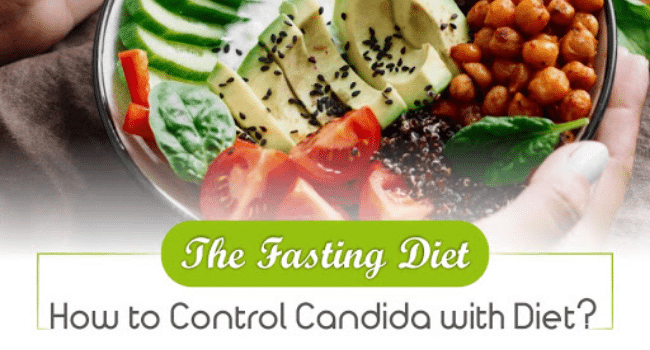Table of Contents
What is Candida Overgrowth?
Candida overgrowth is a type of yeast. Candida overgrowth is a condition wherein the yeast is grown in such excess amounts that it has now become pathogenic. It can cause a multitude of symptoms such as vaginal yeast infection, oral thrush, etc.
To know more about this infection, check out an ebook by Eric Bakker.
What is a Candida Diet?
In general, the candida diet mainly focuses on removing sugar, flour, and yeast from the diet. Instead, it encourages the inclusion of non-starchy veggies, lean proteins, and a ton of healthy fats. It also encourages supplementation heavily. The goal is to stop the foods that feed the overgrowth and consume the ones that curb the growth.
This diet also focuses on using compounds that help the yeast to die off eventually. They also help to eliminate the debris and by-products left by the dead candida cells out from the system.
Main Symptoms of a Candida Infection?
The common symptoms that manifest during a simple yeast infection are –
- Irritation in the vaginal region and vulva
- painful/burning sensation during urination
- Painful sex
- Redness in the private area
- Discharge with a cottage-cheese like consistency
In kids and adults, oral thrush is a common symptom. Oral thrush is marked by a white coating on the cheeks and tongue. There can also be some soreness and redness in the mouth.
When the fungal infection has penetrated your bloodstreams and organs (aka invasive candidiasis), this is a more serious condition that can cause chills and fever. If not treated properly, it could even become life-threatening.
However, the other category of infection which is simply called ‘candida overgrowth’ by some health practitioners says that it can seemingly cause several unrelated and more chronic issues. For example, a common range of symptoms related to candida overgrowth is – chronic fatigue, skin rashes, cystic acne, bowel issues and irregularities, brain fog; just to name a few.
Read More about bioavailable curcumin
5 Diet Foods That Fight Candida
Coconut Oil
Coconut oil is rich in caprylic acid that is helpful in breaking down the yeast cell walls. If you
For someone dealing with chronic candida infection, sticking with topical application of coconut oil can offer great relief.
You can add this oil to a few drops of tea tree oil. This new mixture is a powerful antiseptic and antifungal. However, be sure not to apply this on any open cuts, wounds, and sores.
Probiotics
Probiotics are the holy grail of restoring the gut population and microbes which are the foundation of good health. You can naturally find probiotics in the form of fermented foods such as kefir, kombucha, seaweed, yogurt, kimchi, anything that contains active cultures.
You can also get them from supplementation.
Studies tell us that probiotics can be of immense help when it comes to fighting candida infection.
According to a twelve-week study that involved 215 older participants, regular consumption of lozenges showed a significant improvement in the candida infection of the mouth. The lozenges they took had 2 active strains of lactobacillus.
A low-sugar diet
Yeast grows rapidly when the sugar is available readily in the environment. There’s good evidence that high sugar levels in the bloodstream could increase your risk of developing a candida infection.
It’s common knowledge that sugar has an adverse effect on the digestive system as well as weakens the immune system. A weak immunity has a harder time fighting off infections.
Garlic
Garlic has powerful antimicrobial, antifungal, and antibacterial properties. It has even been studied for its cancer-killing capabilities. It’s better to eat it raw to get the best results.
However, if you have a harder time eating it raw, you can always get it in the form of supplements. For women suffering from intra-vaginal suppository as a result of yeast infection, garlic can be a lifesaver.
Curcumin
Curcumin is found in turmeric, a famous Indian spice. Research tells us that this Indian spice could kill off candida yeast. If not, it could at least help to curb its growth.
Another study tells us that curcumin could hamper Candida’s ability to attach itself to cells. In fact, it was found to be more effective than the antifungal drug fluconazole in treating candida.
How Long It Takes to Get Rid of Candida?
There’s no way to tell how long it might take. Mostly it depends on two things –
- How chronic/serious the infection is
- The nature of the treatment being undertaken
However, it’s safe to say that most mild infections clear out in a couple of days. Sometimes as quickly as 3-4 days. If the infection is in its early stages, it may not even require treatment. However, in case the infection is moderate or severe, it may take up to 2 weeks before you notice an improvement in the symptoms.
Foods to Avoid On a Candida Diet
It’s good to start things with a candida cleanse wherein you drink mostly soups and broths and steer clear of certain foods. Those foods are –
- Sugar fruits like mangoes, bananas, raisins, and figs
- Starchy veggies like corn, potatoes, peas, beans
- Grains containing gluten like barley, wheat, rye
- Farm-raised fish and processed meats
- Processed oils and fats like soybean oil, canola oil, and margarine
- Certain dairy products like soft cheeses and milk
- Artificial sweeteners like aspartame, maple syrup, agave, corn syrup, honey, and simple sugars
- Nuts and seeds like pecans, peanuts, cashews, and pistachios
- Caffeinated drinks and beverages like sodas, coffee, alcohol, tea, etc.
Bottom Line
Candida doesn’t have to be your uncomfortable reality. With the right knowledge and proper consultation – you can fight it off successfully.
Read More on KulFiy:
5 Creative Ways To Add Protein Powder In Your Diet
Weight Loss Tips for When You’ve Tried Everything
